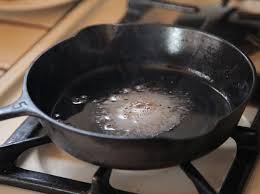





Published on Sep 16, 2023
The objective:Cooking oil is necessary for all kinds of yummy food items from fried chicken to sauteed mushrooms. While the result is usually tasty, the process can get a bit haz y when oil starts to smoke. Have you ever been in the kitchen when the smoke alarm went off? The loud, annoying noise is used to warn people that smoke -- and possibly a fire -- are nearby. While important, it's definitely not fun to have the alarm go off in the middle of cooking dinner. Dive into the world of cooking oil and smoke points to discover just how fast some oils start smoking.
What type of cooking oil has the lowest smoking point?
Oil smoking points have everything to do with chemical composit ion, or the parts that make up the whole. The canola oil you used was unrefined. Unrefined oils usually have a much lower smoke point because the impurities that the refining process strips out are left untouched. In other words, the more impurities, the lower the smoke point.
Olive oil is often refined, which is why it had such a higher smoke point. When you mix oils, like in your third bowl, the smoke point always adopts the same propertise as the oil that had the lowest smoke point -- in this case, the canola oil. What do you think the advantages are of having an oil with a higher smoke point?
Would you enjoy cooking with oil that frequently started smoking. Airing out the house and needing to turn off the smoke alarm can be annoying. Do you think cooking oil's smoking point can be altered by adding other ingredients like water or food? Conduct an another experiment to find out!
1. Canola oil (unrefined)
2. Olive oil
3. 3 bowls
4. Deep frying pan
5. Range hood fan
6. Candy thermometer
7. Measuring cup
8. Pencil
9. Timer
10. Notebook
11. Adult helper
12. Optional (but recommended): safety goggles

1. Open all the windows in your kitchen. You'll want lots of fresh air flowing into your house once the oil start smoking.
2. Pour two cups of canola oil into the first bowl and two cups of olive oil into the second bowl.
3. Pour one cup of canola oil and one cup of olive oil into the third bowl.
4 . You now have your three different types of oil: canola, olive and mixed. Which do you think will smoke have the lowest smoking point (smoke at the lowest temperature)?
5. Write down your guess, or hypot hesis, in your notebook.
6. Turn the stove on to medium heat.
7. Place the deep frying pan on the stove.
8. Pour the contents of the first bowl (the canola oil) into the pan.
9. Carefully put the candy thermometer (or other thermometer capable of measuring high temperatures) into the oil.
10. Have an adult help you watch the oil as it heats up. It's very important to never leave the oil unattended.
11. Once you see the oil begin to smoke, immediately check the thermometer
12. Record the temperature reading in your notebook.
13. Let the oil cool until it is no longer hot or steaming.
14 . Once the pan has cooled as well, clean it out with water and soap before drying it with a towel.
15. Repeat steps 8-14 with the bowl of olive oil and the bowl of mixed oil. Make sure to carefully record the temperature once the oil reaches its smoke point.
16. When you're all done, take a look at your notes. Was your hypothesis correct?
You should have found that the canola oil and the mixed oil had the lowest smoke points. The olive oil's smoke point should have been at a significantly higher temperature.
http://science.hq.nasa.gov/kids/imagers/ems/visible.html
http://en.wikipedia.org/wiki/Electromagnetic_spectrum
http://www.3drender.com/glossary/colortemp.htm
http://www.betterphoto.com/article.asp?id=24
http://www.howeverythingworks.org/sunlight.html
http://www.colormatters.com/colortheory.html
John C. D. Brand (1995). Lines of light: the sources of dispersive spectroscopy, 1800-1930 CRC Press. p. 30–32. ISBN 9782884 4 91631. http://books.google.com/?id=sKx0IBC22p4 C&pg=PA30&dq=light+wavelength+color++young+fresnel
Priest, Irwin G. (1923)."The colorimetry and photometry of daylight ·and incandescent illuminants by the method of rotatory dispersion". JOSA 7 (12): 1175–1209.